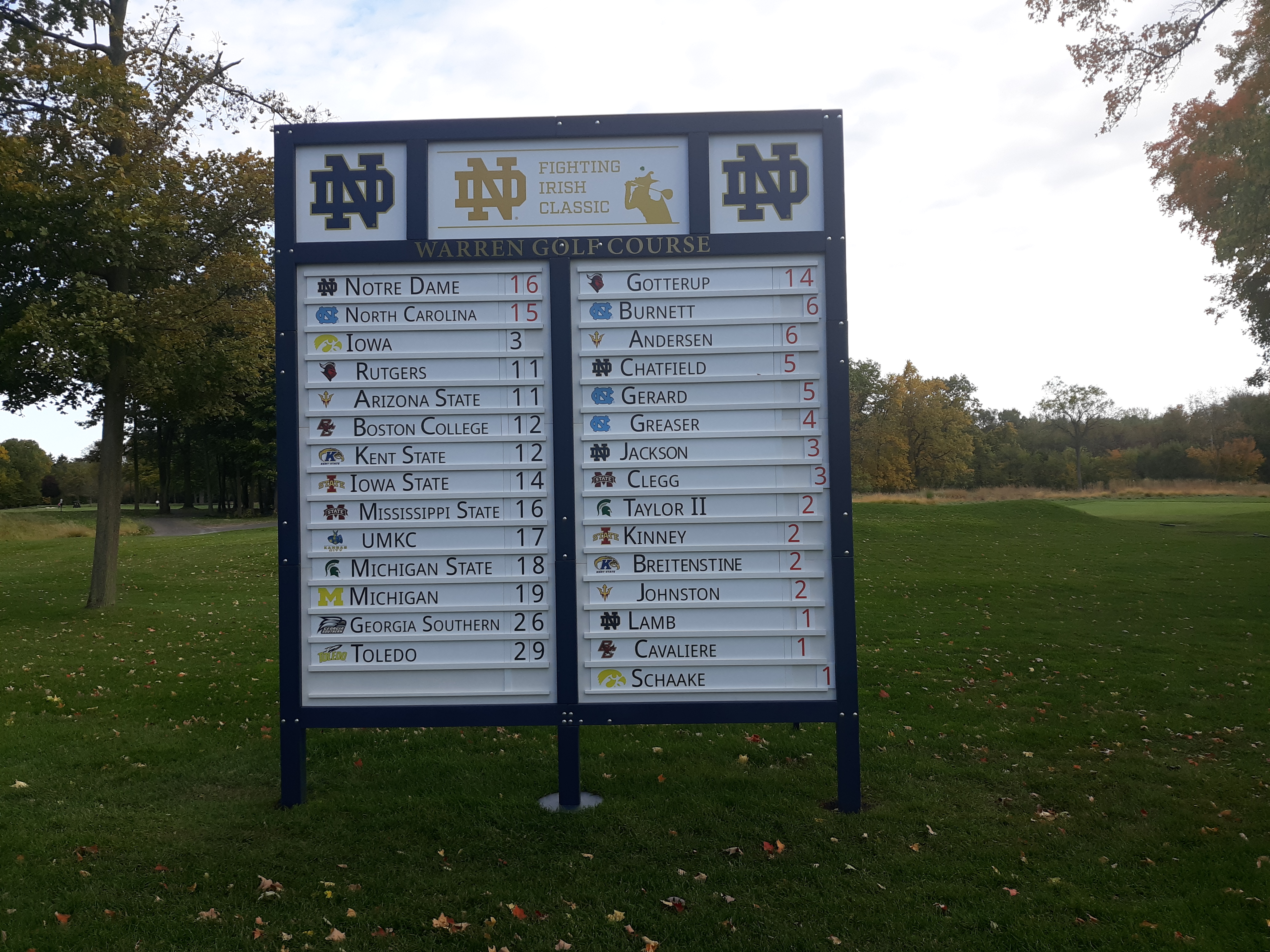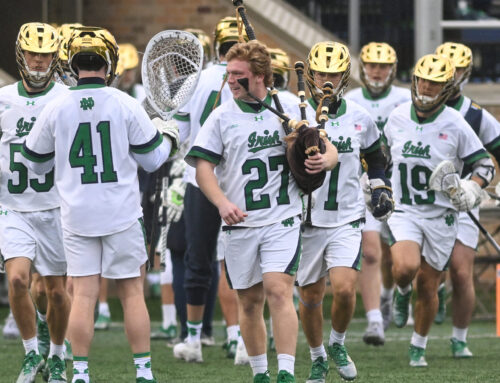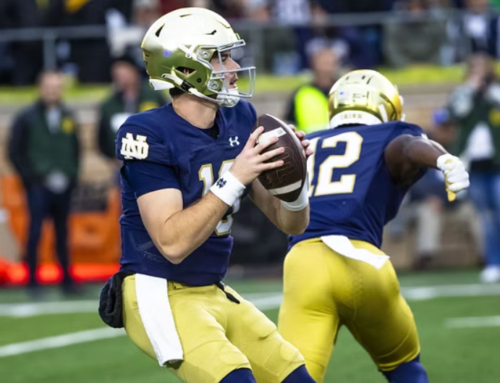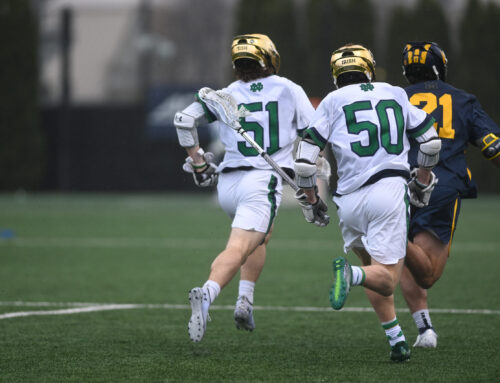In case you missed it, the Fighting Irish golf team is off to its best start ever. The previous post covered the team’s history, players, and coach. This one will give you a introduction to college golf and cover the team’s record breaking fall season.
How Does College Golf Work?
In case this is your first exposure to college golf, here’s a quick primer.
How many guys are on a team? Rosters have a maximum of ten players, but many teams have fewer than that on their roster since teams have 4.5 scholarships to divide amongst everyone.
How does team golf work? Most regular season events consist of three rounds of stroke played over two or three days (although four round stroke play and match play events also exist). Players compete both for their teams and as individuals simultaneously. The individual competition is just like a normal golf tournament, the lowest score wins.
For the team event, there are five players from each school. Each round, the worst score is thrown out, and the low four are counted. Note that the scores are totalled at the end of each round. If a player shoots 10 shots worse than the next highest score in the first round, that score isn’t counted. With a good second or third round, they can still contribute to the team. Lastly, many events have extra spots for additional individuals. While, only five players from a school compete in the team event, remaining members of the team can compete as individuals if there’s space in the field. A team hosting their own event will usually make sure all the players on their roster have a spot in the field.
When is college golf’s season? College golf is basically year round with a break for winter. Teams compete in regular season tournaments in both the fall and spring semesters. Fall events take place in September, October, and early November. The season restarts in late January and continues through May, culminating with conference tournaments, NCAA Regionals, and NCAA Nationals.
How do NCAA Regionals and Nationals work?: After conference tournaments, 81 teams and 45 individuals on non-qualifying teams make regionals. The 31 conference champions get auto-bids, and a committee selects the remaining at-large teams and individuals in a similar process to March Madness. There’s even a selection and seeding show on Golf Channel! There are six regional sites around the country, but teams may not end up at the closest site to make sure fields at each regional are relatively balanced. Notre Dame’s Warren Course is hosting a women’s regional this year, and has hosted men’s regionals in the past. The five best teams at each Regional and top individual on a non-qualifying team make Nationals.
Nationals consists of four rounds of stroke play to crown an individual champion. For the team competition, the low eight teams after stroke play qualify for a match play, and are seeded in order of finish. In match play, each of the five players faces off against a player from the opposing school in an 18 hole match. Each match is worth one point (half points for ties), and a team that wins at least three points advances. The eight team bracket continues until a champion is crowned. The event is almost always one of the best watches on the golf calendar (pro and amateur) as it feels like a mini-Ryder Cup complete with awkward celebrations (see video below). The final round of stroke play and each round of match play is broadcast on Golf Channel.
Who are the top teams? Generally the best college golf programs are the P5 schools in the southern parts of the ACC, Big 12, SEC, and PAC 12. Stanford won the 2019 National Championship over Texas. Alabama, Oklahoma, Oklahoma State, Texas, Oregon, and LSU have all recently won titles. Led by Patrick Reed, Augusta State won back-to-back titles in 2010 and 2011, and remains the last non-P5 school to win. Minnesota won the 2002 Championship, and was the last midwestern school to claim a natty.
How competitive is college golf? Very. Many top college players finish their college careers and compete on the PGA Tour just a few weeks after Nationals. The 2019 college class was particularly notable. Oklahoma State’s Matthew Wolff and Cal’s Collin Morikawa both won PGA Tour events within a few months of leaving school. Additionally, the individual championship is a solid indicator of future professional success. Multiple time major winners Jack Nicklaus (Ohio State), Curtis Strange (Wake Forest), Ben Crenshaw (Texas), Hale Irwin (Colorado), Phil Mickelson (Arizona State), and Tiger Woods (Stanford) all won individual NCAA championships.
How does one follow college golf? Golfstat is an invaluable tool. It has a live leaderboard of pretty much every men’s and women’s college event. They also have their own computer ranking system of the top teams and players that is used heavily by NCAA selection committee. Golfweek.com, GolfChannel.com, and AmateurGolf.com also have solid college event coverage. Lastly, Golf Channel, ESPN3, and conference networks broadcast occasional events each year.
Pushcarts? While coaches can give advice to players on the course, they can’t carry a player’s bag. Caddies aren’t allowed either, so pushcarts are fairly popular. Join the mafia.
.@StanfordMGolf is moving on to the Championship Match! 🌲#NCAAGolf pic.twitter.com/DUw9VIjev1
— Golf Channel (@GolfChannel) May 28, 2019
Irish Season Starts Strong
The Irish opened the season at the Badger Invitational at University Ridge in Madison flying very under the radar. The team got a single 25th place vote in the preseason Coaches Poll. Notre Dame shot the low round of day one, and shared the lead with Kansas after the second at eight-under. In the final round, Notre Dame blew away the field. As a team, the Irish shot a combined -14 over the last 18 holes to win the event by 14 shots over Kansas. The 22-under mark tied a program record for lowest score at a 54 hole event. Senior Hunter Ostrum finished in second as an individual shooting -11, one shot behind the winner from Nevada. Sophomore Davis Chatfield added a top-10 shooting -7 good for a T6 finish.
Next up was a short trip to Chicago for Northwestern’s Windon-Memorial at Conway Farms. The Irish shot ten-under over the first two rounds to lead by four over Ole Miss. In the final round, Irish shot a combined even par to secure the win. Furthermore, Notre Dame (-10) and Ole Miss (-5) were the only teams to finish under par. The tournament also marked just the second time in program history the team won back-to-back events. Ostrum once again had the top Irish finish shooting -5 to finish in third. Freshman Palmer Jackson finished one shot back of his teammate at -4, good for fourth.
Facing a tougher field and tougher venue, the season continued for the Irish at the Inverness Intercollegiate. At six-time major venue, Inverness Club, Notre Dame (+10) sat in second after 36 holes, four back of Tennessee (+6). The final round saw the Irish make up three shots on the Vols, but both were passed by Texas Tech. The Red Raiders shot a blistering 12-under (272) to win the event by eight. Still, the third place finish for ND was nothing to be ashamed of. Once again, Ostrom finished in the top-10 shooting two over par over the three rounds while senior Davis Lamb finished fourth at +1. After the strong September, the nation finally started to take notice of the Irish. The team went from unranked to being the season to 12th in the Golfweek Coaches Poll.
👀… #GoIrish ☘️ pic.twitter.com/yogaeiz3DO
— Notre Dame Men’s Golf (@NDMensGolf) September 28, 2019
Irish Defend Their Home Turf
The Irish hosted a strong field at their home tournament, the Fighting Irish Classic at Warren Golf Course. Along with Notre Dame, North Carolina and Arizona State were the favorites heading into the event. The Irish started a bit slowly finishing the first round one under par and four shots behind UNC. In the second, however, they raced away from the field with a -13 (271) round to take a seven shot lead into the final round the following day. It was a clear two horse race as ND and UNC (-7) were the only schools under par.
The Tar Heels started strong on the front nine of the final round, cutting the Irish lead to just one shot going into the inward nine. Both schools made loads of birdies down the stretch. Ostrum shot a blistering six-under 30 on the back with an eagle and four birdies. Playing in the same group, UNC’s Ryan Burnett shot a bogey-free 32 with two birdies and an eagle of his own. Both school’s traded the lead throughout the back nine, and neither ever led by more than a shot. The Irish gained a one shot lead as all four of their counting players finished birdie-par on 17 and 18. Ultimately, the tournament came down to UNC’s Austin Greaser needing to play the last two holes in one-under to force a tie. After making par on the par-5 17th, Greaser hit his approach on the tough par-4 18th to around 20 feet. His tying putt slid by on the low side giving the Irish the title.
Chatfield led the Irish with a T4 finish at -5 highlighted by a seven-under 64 in the second round. Palmer Jackson picked up his second top-10 of the season finishing T7 at -3 despite a rough back-nine in the final round. With the win, the Irish became the first college team to win three events in the 2019 season. They also equalled the 1999/2000 team program high mark of three wins in a season, doing so in just four events. Golf Channel also took notice, and published a nice profile of the Irish squad.
A struggling program for many years, the @NDMensGolf Fighting Irish are now living up to their name.@BrentleyGC with your #NCAAGolf weekly update: https://t.co/SJ3HiuWiAI pic.twitter.com/O167Zieu5L
— Golf Channel (@GolfChannel) October 9, 2019
Irish Finish the Fall in Dramatic Fashion
The Irish headed to the Quail Valley Collegiate in Vero Beach, Florida for final tournament of the fall with a shiney #10 ranking in the Golfweek poll. This event has been kind to the Irish as the 2017/18 team set their program scoring record here at 22-under. Notre Dame finished the first round tied for second with Memphis shooting 11-under (277). USF jumped out to a big lead with a 20-under round (268). ND responded with the low score of the second round finishing with an 18-under score, giving them a two shot lead over USF. In the individual event, Palmer Jackson sat in second place at 11-under, just one shot back of the leader.
Just like their previous event, the Quail Valley Collegiate had another drama-filled finish. Memphis, ND, and USF spent the afternoon within two shots of each other in a birdie-filled back-nine. Notably, Phuripon Namkang from Memphis birdied the last five holes to keep the Tigers on pace with the other schools. Once again, the championship would come down to the final hole. Notre Dame and USF sat tied atop the leaderboard at 42-under par, Memphis was at -40, and Jackson was the only counting player left to play the 18th. The freshman rolled in birdie putt on the 452 yard par-4 to claim the title for the Irish.
The birdie also gave Jackson a two stroke victory in the individual championship at 16-under (200). ND Sophomore Taichi Kho, competing as an individual, finished tied for second at -14. Davis Lamb also added another top-10, finishing in a tie for ninth at -9. As has been the case throughout the fall, some edits to the record book were required. The four tournament wins set a program record for wins in a season. Additionally, the 43-under total blew away the program scoring record by 21 shots. The 18-under second round of 270 was also a program record for low round. Lastly, Jackson’s 16-under par set a 54 hole individual scoring record.
Freshman @pdjack_ claims his 1st individual 🏆 of his career.
Jackson shot a 200 (-16) at Quail Valley, winning by ✌️ strokes. #GoIrish ☘️ pic.twitter.com/kxVrUhZKDj
— Notre Dame Men’s Golf (@NDMensGolf) October 21, 2019
A Dream of Spring
Since winter is coming to much of the country, the fall college golf season is winding down. Notre Dame’s next event isn’t until late February when the Irish will travel to Puerto Rico for the TPC Dorado Beach Collegiate. After the trip to Puerto Rico, the Irish will head south throughout March with tournaments in Hilton Head, South Carolina, Statesboro, Georgia, and Awendaw, South Carolina. The regular season culminates with a trip to Augusta, Georgia in early April. While it’s not The Masters, the Augusta Invitational is one of the top college tournaments of the year, and is held the weekend before the professional invitational in Augusta.
The ACC Tournament kicks off the postseason on April 17th. This year’s event will be held at Old North State Club, the home course of NC State. A new format was adopted this year to more closely mirror the NCAA Nationals format. The event will consist of 54 holes of stroke play followed by the top four teams playing a match play bracket. As noted above, NCAA Nationals has four rounds of stroke play and an eight team bracket. As the ACC currently has seven teams (GT, Wake, ND, Duke, Louisville, UNC, and Clemson) in the top-15 of the latest coaches poll, this should be a highly competitive tournament. After ACCs, qualifying teams head to NCAA Regionals. With the season they’ve had so far, the Irish are in a good spot to earn a Regionals bid for the first time since 2012. Michigan State is hosting the closest Regional, but it’s no guarantee the Irish will end up in East Lansing if they qualify. Should the Irish make Regionals and finish in the top-5 there, they’ll head to Nationals. This year’s championship is hosted by Arizona State at Greyhawk Golf Club in Scottsdale.
🏆👏
Congrats to @NDMensGolf for not only being the Fighting Irish Classic champs but the first college team to win 3 tournaments this fall!#GoIrish☘ pic.twitter.com/Wyfzzmezp6
— The Fighting Irish (@FightingIrish) October 11, 2019




